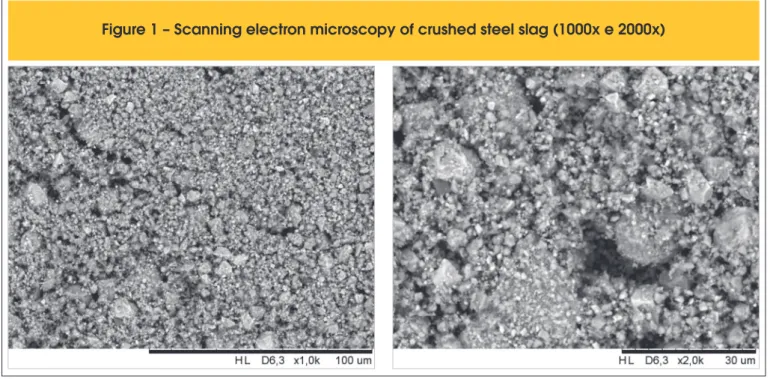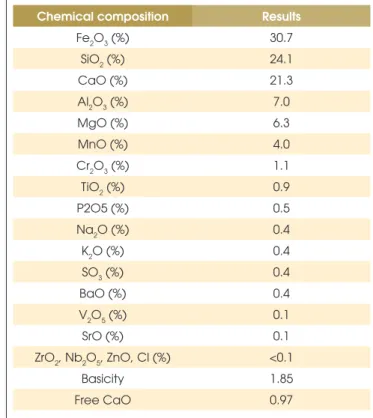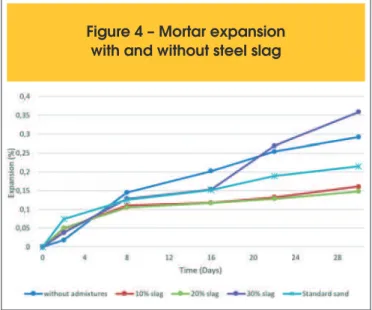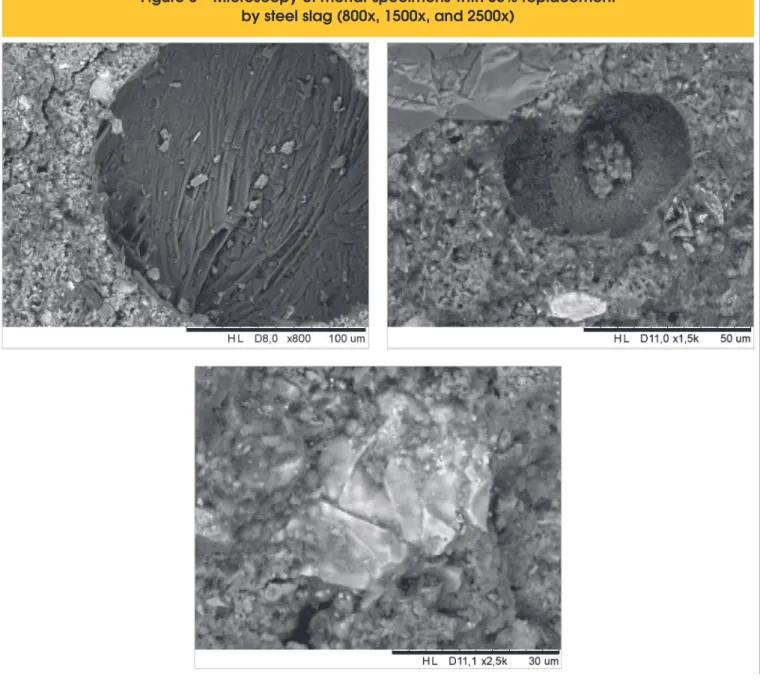Study of efect of electric arc furnace slag on expansion
of mortars subjected to alkali-aggregate reaction
Estudo dos efeitos do uso da escória de aciaria
na expansão de corpos de prova sujeitos à reação
álcali-agregado
a Universidade Tecnológica Federal do Paraná, Departamento Acadêmico de Construção Civil, Câmpus Pato Branco, Pato Branco, PR, Brasil; b Escola de Engenharia de São Carlos, Universidade de São Paulo, Departamento de Engenharia de Estruturas, São Carlos, SP, Brasil.
L. SOUZA a
luciene__@hotmail.com
E. R. ZOLETT b eliszolett@hotmail.com
R. CARRAZEDO b rogcarrazedo@sc.usp.br
Abstract
Resumo
Alkali-aggregate reaction is a chemical reaction between cement alkalis and some reactive mineral present in some aggregates, leading to con-crete expansion and cracking. One kind usually observed and studied in Brazil is the alkali-silica reaction, due to its fast development. There are
several methods that are efective to control and mitigate this reaction, and one of them is the partial replacement of cement by mineral additions such as pozzolans like ly-ash, silica fume and slag. In this study, we propose the use of electrical steel slag as a partial replacement of cement, evaluating its efectiveness by NBR 15577:2008, employing diferent proportions as replacement. It seems that the electrical steel slag, despite its expansive behavior, has been efective in the control of the ASR.
Keywords: concrete expansion, alkali-aggregate reaction. alkali-silica reaction, pozzolans, steel slag.
A reação álcali-agregado (RAA) é uma reação que ocorre entre os álcalis do cimento e alguns compostos minerais presentes em determinados
agregados, gerando consequências ao concreto, como por exemplo, issuração. A reação com maiores ocorrências registrada no Brasil é a re -ação álcali-sílica (RAS), devido à rapidez com que esta ocorre em função das formas minerais reativas envolvidas. Vários métodos estudados
já se comprovaram eicazes para o controle desta reação, sendo um deles a substituição parcial de cimento por adições como as pozolanas,
dentre as quais podem ser citadas as cinzas volantes e as escórias de origem siderúrgica. Neste sentido, este trabalho tem por objetivo o
estu-do da utilização da escória de aciaria elétrica como redutor da reação álcali-agregaestu-do, senestu-do desenvolviestu-do com base nas orientações da NBR 15577:2008 Agregados – Reatividade Álcali-Agregado, avaliado para diferentes proporções de substituição parcial de cimento por escória. A
escória de aciaria elétrica, uma pozolana não tradicional resultante do processo de produção do aço e de características expansivas, teve êxito ao reduzir a expansão da RAS.
1. Introduction
Alkali aggregate reaction (AAR) is a chemical reaction, which oc-curs between alkalis from cement paste and some alkaline reac-tive minerals in aggregates. This reaction form a viscous
hygro-scopic gel that ills concrete voids leading to damage and reducing
the concrete structure life span [1].
There are mainly two types of AAR, alkali-silica reaction (ASR) and alkali-carbonate reaction (ACR), according to the aggregate reac-tive minerals.
Alkali-silicate reaction can be classiied as a speciic type of ASR,
for its resemblance, because low degree of crystalline silicates or amorphous silicates usually develop alkali-silica reaction while highly crystalline silicates develop alkali-silicate reaction [2]. In this sense, alkali-silicate is observed in opal, amorphous silica, chert or chalcedony, cristobalite or tridymite, natural volcanic and boro-silicate glasses, when reacts with cement alkalis and calcium hy-droxide. Alkali-silica reaction and alkali-silicate reaction is the most common type of AAR in Brazil, been found in several structures [3].
If properly identiied, it is possible to minimize the expansion and
related cracking. If the aggregate is potentially reactive, replace-ment may be considered, but cost must be evaluated. Reactive aggregate partial replacement may reduce the potential for expan-sion. Collins and Bareham [4] partially replaced a reactive aggre-gate by a porous aggreaggre-gate, suppressing the expansion through the dilution of alkali concentrations by water absorbed in the po-rous aggregate. Ducman et al [5] also employed a porous aggre-gate, yet highly reactive. The porous structure of the aggregate were able to accommodate the gel produced, without causing ex-pansion or cracks in the evaluated mortar bars.
Low-alkali cement can also minimize alkali hydroxide concentra-tion in the concrete pore soluconcentra-tion, reducing the potential for expan-sion. Nevertheless supplementary cementitious materials and ex-ternal sources of alkalis like deicers and seawater, can contribute to total alkali content of concrete [6].
The expansion reduction may also be attained by chemical addi-tions to the concrete, like lithium compounds. Qinghan et al [7] and
Lumley [8] indicate that lithium compounds are efective to inhibit
ASR expansion, because it replaces sodium and potassium
alka-line ions in ASR gel, densifying it. Notice that, if insuicient lithium
is used, the expansion may increase, because lithium compounds may combine with calcium hydroxide as well, producing calcium salts and lithium hydroxide, and increasing hydroxyl ions concen-tration in the pore solution [9]. Mo et al [10] say that some lithium salts do not release hydroxyl ions in the pore solution as it reacts, leading to best results.
and observed that it did not increase hydroxyl ions in the concrete pore solution, and was able to inhibit ASR expansion. Qian et al
[12] observed that lithium hydroxide and lithium salts were efec -tive to suppress ASR but started Alkali-Carbonate Reaction. Silva [13] observed that, beyond a threshold, lithium nitrate had no more
inluence on the ASR inhibition, and, after a 30 days test, lithium nitrate hold ASR expansion while ly-ash did not.
Mineral additions can be used as supplementary cementitious material and suppress ASR expansion [14]. The most common
materials are natural pozzolans, ly-ash, slag, silica fume and rice
husk ash. These materials can suppress ASR expansion and also improve some concrete properties, such as permeability, heat
re-sistance (slower conductivity rate), smaller difusivity (due a denser
matrix) and overall durability increase [15].
Munhoz [16] veriied that, as blast furnace slag, ly-ash, metaka -olin, silica fume are mixed in concrete at increasing amounts, ex-pansion due AAR is reduced. Silveira [17] had similar results with rice husk ash.
Ramachandran [18] stated that mineral additions, such as natural
pozzolans, ly-ash, blast furnace slag, silica fume and rice husk ash, would only be efective to inhibit alkali-aggregate reaction ac -cording to their chemical composition (SiO2 percentage and free alkali ions), to the mixed amount, to the aggregate type (kind of AAR) and to the cement alkali (Sodium, Potassium or Lithium). Electric arc furnace steel slag is a by-product of steel production, with-out commercial value and treated like waste, because is made of
im-purities removed during steel reining operation. Steel slag is mainly
composed by lime (calcium oxide – CaO) and magnesia (magnesium oxide – MgO), with porous structure where water migrates, react-ing with free calcium oxide to form lime slurry (calcium hydroxide - Ca(OH)2) that has crystalline structure and twice volume. This volume change leads to stresses, cracks and expansion [19]. Steel slag has high Calcium/Silicate ratio, which means that free calcium oxide has potential to expand when mixed in concrete [20]. Notice that the con-crete expansion due AAR is dependent on Ca content [21].
Luxán et al [22] studied the chemical stability and the mineralogi-cal compounds of electric arc furnace slag, stating that the studied slag may be employed as building material. Tsakiridis et al [23] employed steel slag as raw material for the production of cement
clinker, showing that the addition of steel slag did not afect cement
sintering, the hydration process during production, and had similar mechanical characteristics to usual Portland cement clinker. Qiang and Peiyu [24] also pointed out that the hydration compounds of steel slag are mainly CSH gel and lime slurry, very similar with those of cement.
Table 1 – Cement characteristics – CP V ARI RS
Property Test method Results Limits NBR 15577-4
Na2O alkali equivalent* NBR 14 656 0.780 % (0.90±0.10) %
Free calcium oxide NBR NM 12 1.31 % –
Blaine fineness NBR NM 76 4743 cm2/g (4900±200) cm2/g
Autoclave expansion ASTM C 151 0.08 % < 0.20%
Xuequan et al [25] developed a cement made of clinker, steel slag
and ly-ash, with cementitious properties close to Portland cement,
consuming part of the alkali during hydration, which would reduce expansion due to AAR.
This paper evaluates the electric arc furnace steel slag as partial replacement of Portland cement, instead of raw material for ce-ment clinker production, aiming to suppress alkali-silica reaction, based on the methodology established by the Brazilian standard NBR 15577:2008 [26]. Next, we present the characteristics of the material employed in this study and the techniques to evaluate
it. Then, the results are presented, and inally some conclusions
are drawn.
2. Materials and methods
The materials used were: high early strength Portland cement with improved resistance to sulphate attack (CP V ARI RS), with characteristics presented in Table 1 and following the fea-tures required by NBR 15577:2008; fine grained basalt with volcanic glass scattered throughout the rock; Brazilian stan-dard sand – a reference sand that must be used for cement
tests, with characteristics presented in Table 2; and electric arc furnace steel slag.
The slag has been crushed and milled in a ball mill into powder form, using only the material passing through 0.075 mm sieve. Fig-ure 1 presents a sample employing scanning electron microscopy (SEM). One may notice that slag grain shows a round form, with
particle size under 10μm, but most of it has size under 3μm. Figure 2, obtained with the aid of a laser difraction particle size analyzer,
shows that the particle size distribution of the slag is close to par-ticle size distribution of the cement, meaning that the slag can be used as a mineral addition.
To identify the composition of the slag, an X-ray difraction was car -ried out. The main compounds present were periclase (magnesium oxide), quartz (silicate), lime (calcium oxide), alkalies (potassium and sodium), dolomite (CaCO3.MgCO3) and calcite (CaCO3), that
can be veriied through the difractogram of Figure 3.
Table 3 shows the slag chemical composition obtained by X-ray
luorescence spectrometer, while Table 4 shows its apparent (bulk)
density and volumetric instability, evaluated with Brazilian standard NBR 11582:2012 [27]. Notice that the slag did not show expansion, but it was only evaluated until 7th day.
Table 2 – Standard sand characteristics
Property Results Limits NBR 7412:1982
Material passing through 0.075 mm sieve 0.0% ≤ 1.0%
Conglomerate clayey 0.0% ≤ 0.2%
Feldspar content of sieves 2.4 and 1.2 mm 2.4 % ≤ 15.0 %
Mica content of sieve 0.3 and 0.15 mm 1.9 % ≤ 2.0 %
Organic impurities < 100 ppm ≤ 100 ppm
Source: IPT [28]
Following NBR 15577:2008, parts 4 and 5, three mortar bars (25±0,7 mm by 25±0,7 mm by 285 mm) were cast for each mixture, with mix design by mass of 1 part of cement, 2.25 parts of selected
aggregate (either ine grained basalt or standard sand), and water/
Figure 2 – Particle size distribution of slag
and cement by laser diffraction
particle size analyzer
Figure 3 – Steel slag diffractogram
Fe2O3 (%) 30.7
SiO2 (%) 24.1
CaO (%) 21.3
Al2O3 (%) 7.0
MgO (%) 6.3
MnO (%) 4.0
Cr2O3 (%) 1.1
TiO2 (%) 0.9
P2O5 (%) 0.5
Na2O (%) 0.4
K2O (%) 0.4
SO3 (%) 0.4
BaO (%) 0.4
V2O5 (%) 0.1
SrO (%) 0.1
ZrO2, Nb2O5, ZnO, Cl (%) <0.1
Basicity 1.85
binder ratio of 0.47. Twelve diferent mixtures were prepared con -taining 0, 10, 20 and 30% by mass replacement of cement by slag. Three mortars were mixed without reactive aggregate and without slag, only with standard sand and Portland cement, for reference. The cement replacement ratio is shown in Table 5.
The specimens were cured in a moisture room for a period of
24 hours. After that, mortars received identiication tags and the
initial length of each specimen was measured. The specimens were then stored in a climatic chamber with temperature of 80ºC immersed in distilled water. After another measurement was taken, the specimens were immersed in a 1N sodium hydroxide (NaOH) solution, at a temperature of 80ºC. Expansion rate is increased due temperature, while the sodium hydroxide solution provides enough alkaline ions. Following NBR 15577:2008, the specimens were measured at 8, 16, 22 and 30 days.
3. Results and discussion
Figure 4 presents the average expansion measured in all specimens. The relative expansion is obtained by the following expression:
(1)
4 5
4
E E
R 100
E
-=
where R is the percentage reduction of mortar expansion, E4 is the average expansion of the mortar without mineral addition (without slag - %) and E5 is the average expansion of mortars with mineral addition (%). Results are presented in Figure 5.
Figures 4 and 5 show that slag was able to reduce expansion due AAR. Nevertheless, it should be employed with caution. Good re-duction is achieved with 20% of cement replacement by slag, with expansion of 0.12% at 16 days and 0.15% at 30 days.
According to NBR 15577-1:2008, a mineral addition is considered
efective only if expansion is under 0.10% at 16 days, which was
not attained by any of the proposed replacements. It worth notice, nevertheless, that the expansion was reduced about 40%, as seen in Figure 5. Probably the basaltic aggregate is highly reactive to
Table 4 – Steel slag
characteristics
Property Steel slag
Apparent (bulk) density 3.76 g/cm3
Expansibility (NBR 11582) 0 mm
Table 5 – Cement replacement ratio
Replacement ratio 1 2.25 0.47
Cement (g) Slag (g) Aggregate (g) Water (g)
0% (Reference) 146.67 – 330.00 68.93
10% 132.00 14.67 330.00 68.93
20% 117.34 29.33 330.00 68.93
30% 102.66 44.01 330.00 68.93
Sand (no reactive) 146.67 – 330.00 68.93
Figure 4 – Mortar expansion
with and without steel slag
centage reduction (R) of mortar
alkalis, and it might be interesting to test the replacement with a less reactive aggregate, as stated by the Brazilian standard. It is also worth point out that the expansion in mortar with 30% of cement replacement by slag was reduced about 25% at 16 days, but expansion is observed after 30 days. Figure 6 shows a scanning electron microscopy made in a mortar with 30% of cement replacement. The first and second sub-image, with zoom of 800x and 1500x, show a slag grain, with reaction rim. The third sub-image shown an aggregate grain, with no re-action rim, indicating that the rere-action is probably restrained, maybe even suppressed. Latter expansion could then be caused by free calcium oxide [20].
A point to be clariied remains, in which the excess calcium rather
than assist in expansion as would be expected (see [21] for ex-ample), reduced the alkali-aggregate reaction.
4. Conclusions
Evaluation of the efectiveness of the use of steel slag in reducing
expansion due to alkali-aggregate reaction has been studied. The
ine grained basalt with volcanic glass scattered throughout the
rock was highly reactive, with expansion of 0.86 mm (0.29%) at 30 days in the accelerated mortar-bar test set by Brazilian standard NBR 15577:2008.
Regarding the steel slag addition, it is observed that at 16 days
there was signiicant reduction in the mortar expansion due AAR
with 10% and 20% of cement replacement, setting almost 54% of expansion reduction. Despite it, expansion is above the limit of
0.10% set by Brazilian standard NBR 15577:2008. Furthermore,
expansion still develops the end of the measurement, at 30 days, which implies that the reason behind expansion is still there.
It has been considered that the reason for the expansion is the ex-cess of free calcium oxide and magnesium oxide, since no reaction rim or gel bags were observed in the specimens with 10, 20 or 30% of cement replacement by steel slag.
In this sense, we conclude that a steel slag with high content of
cal-cium oxide (CaO) may have opposite efect to the expected, which
may mitigate AAR yet expansion still develop due the presence of free calcium oxide and magnesium oxide.
5. Acknowledgment
Authors acknowledge UTFPR-PB for inancial support and LAC -TEC – Institute of Technology for Development by providing the re-active aggregate. We also acknowledge prof. Dr. Caroline Angulski
da Luz for the assistance in the analysis of X-ray difraction and laser difraction particle size analyzer.
6. Bibliography
[1] Pan, J. W.; Feng, Y. T.; Wang, J. T.; Sun, Q. C.; Zhang, C. H.; Owen, D. R. J. Modeling of alkali-silica reaction in concrete: a review. Frontiers of Structural and Civil Engineering, v.6, n.1, 2012; p.1-18.
[2] Tiecher, F. Inluence of the crystallinity and deformation of
quartz on alkali-aggregate reaction – in portuguese. Ph.D. Thesis, Federal University of Rio Grande do Sul, Porto Alegre, 2010.
[3] Couto, T. A. Alkali-aggregate reaction: a study of the phe-nomenon in siliceous rocks – in portuguese. Master thesis, Federal University of Goiás, Goiânia, 2008.
[4] Collins, R. J.; Bareham, P. D. Alkali-silica reaction: suppres-sion of expansuppres-sion using porous aggregate. Cement and Concrete Research, v.17, n.1, 1987; p.89-96.
[5] Ducman, V.; Mladenovic, A.; Suput, J. S. Lightweight aggre-gate based on waste glass and its alkali-silica reactivity. Ce-ment and Concrete Research, v.32, n.2, 2002; p.223-226. [6] Jensen, A. D.; Chatterji, S.; Christensen, P.; Thaulow, N.;
Gudmundsson, H. Studies of alkali-silica reaction. Part 1: a comparison of two accelerated test methods. Cement and Concrete Research, v.12, n.5, 1982; p.641-647.
[7] Qinghan, B.; Nishibayashi, S.; Xuequan, W.; Yoshino, A.; Hong, Z.; Tiecheng, W.; Mingshu, T. Preliminary study of ef-fect of LiNO2 on expansion of mortars subjected to alkali-silica reaction. Cement and Concrete Research, v.25, n.8, 1995; p.1647-1654.
[8] Lumley, J. S. ASR suppression by lithium compounds. Ce-ment and Concrete Research, v.27, n.2, 1997; p.235-244. [9] Diamond, S. Alkali Silica Reactions - some paradoxes.
Ce-ment and Concrete Composites, v.19, n.5-6, 1997; p.391-401;
[10] Mo, X.; Jin, T.; Li, G.; Wang, K.; Xu, Z.; Tang, M. Alkali-aggre-gate reaction suppressed by chemical admixture at 80oC. Construction and Building Materials, v.19, 2005; p.473-479. [11] Diamond, S. Unique response of LiNO3 as an alkali silica
reaction-preventive admixture. Cement and Concrete Re-search, v.29, n.8, 1999; p.1271-1275.
[12] Qian, G.; Deng, M.; Tang, M. Expansion of siliceous and do-lomitic aggregates in lithium hydroxide solution. Cement and Concrete Research, v.32, n.5, 2002; p.763-768.
[13] Silva, D. J. F. Study of efects of lithium nitrate on expansion
of mortars subjected to alkali-silica reaction – in portuguese. Master thesis, São Paulo State University, Ilha Solteira, 2007.
[14] Monteiro, P. J. M.; Wang, K.; Sposito, G.; Santos, M. C.;
An-drade, W. P. Inluence of mineral admixtures on the
alkali-aggregate reaction. Cement and Concrete Research, v.27, n.12, 1997; p.1899-1909.
[15] Bijen, J. Beneits of slag and ly-ash. Construction and Build -ing Materials, v.10, n.5, 1996; p.309-314.
[16] Munhoz, F. A. C. Efect of mineral admixtures in controlling
the alkali-silica reaction and alkali-silicate reaction – in por-tuguese. Master Thesis, Polytechnic School of the University of São Paulo, São Paulo, 2007.
[17] Silveira, A. A. Contribution to the study of rice husk ash ad-mixtures on concretes submitted to alkali-agreggate reac-tions – in portuguese. Ph.D. Thesis, Federal University of Rio Grande do Sul, Porto Alegre, 2007.
[18] Ramachandran, V. S. Alkali-aggregate expansion inhibiting admixtures. Cement and Concrete Composites, v.20, n.2-3, 1998; p.149-161.
[19] Masuero, A. B.; Dal Molin, D. C. C.; Vilela, A. C. F. Stabilization and technical feasibility of electric steel slag – in portuguese. Ambiente Construído (On-line), v.4, n.2, 2004; p.57-81. [20] Hermann, A.; Souza, L.; Luz, C. A.; Pereira Filho, J. I.
Val-orização da escória de aciaria em cimentos aluminosos e cimento Portland. In: Encontro Latino-americano sobre
Edi-icações e Comunidades Sustentáveis, Vitória-ES, 2011.
[21] Lindgard, J.; Andiç-Çakir, O.; Fernandes, I.; Ronning, T. F.; Thomas, M. D. A. Alkali-silica reactions (ASR): Literature
review on parameters inluencing laboratory performance
testing. Cement and Concrete Research, v. 42, 2012; p.223-243.
[22] Luxaân, M. P.; Sotolongo, R.; Dorrego, F.; Herrero, E. Char-acteristics of the slags produced in the fusion of scrap steel by electric arc furnace. Cement and Concrete Research, v. 30, 2000; p. 517-519.
[23] Tsakirids, P. E.; Papadimitriou, G. D.; Tsivilis, S.; Koroneos, C. Utilization of steel slag for Portland cement clinker pro-duction. Journal of Hazardous Materials, v. 152, 2008; p. 805-811.
[24] Qiang, W.; Peiyu, Y. Hydration properties of basic oxygen furnace steel slag. Construction and Building Materials, v. 24, 2010; p. 1134-1140.
[25] Xuequan, W.; Hong, Z.; Xinkai, H.; Husen, L. Study on steel
slag and ly ash composite Portland cement. Cement and
Concrete Research, v. 29, 1999; p. 1103-1106.
[26] Brazilian Technical Standards Association. Aggregates: Al-kali-aggregate reactivity. NBR 15577, Rio de Janeiro, 2008. [27] Brazilian Technical Standards Association. Portland cement
– Determination of soundness by the Le Chatelier method – Method of test. NBR 11582, Rio de Janeiro, 2012.




